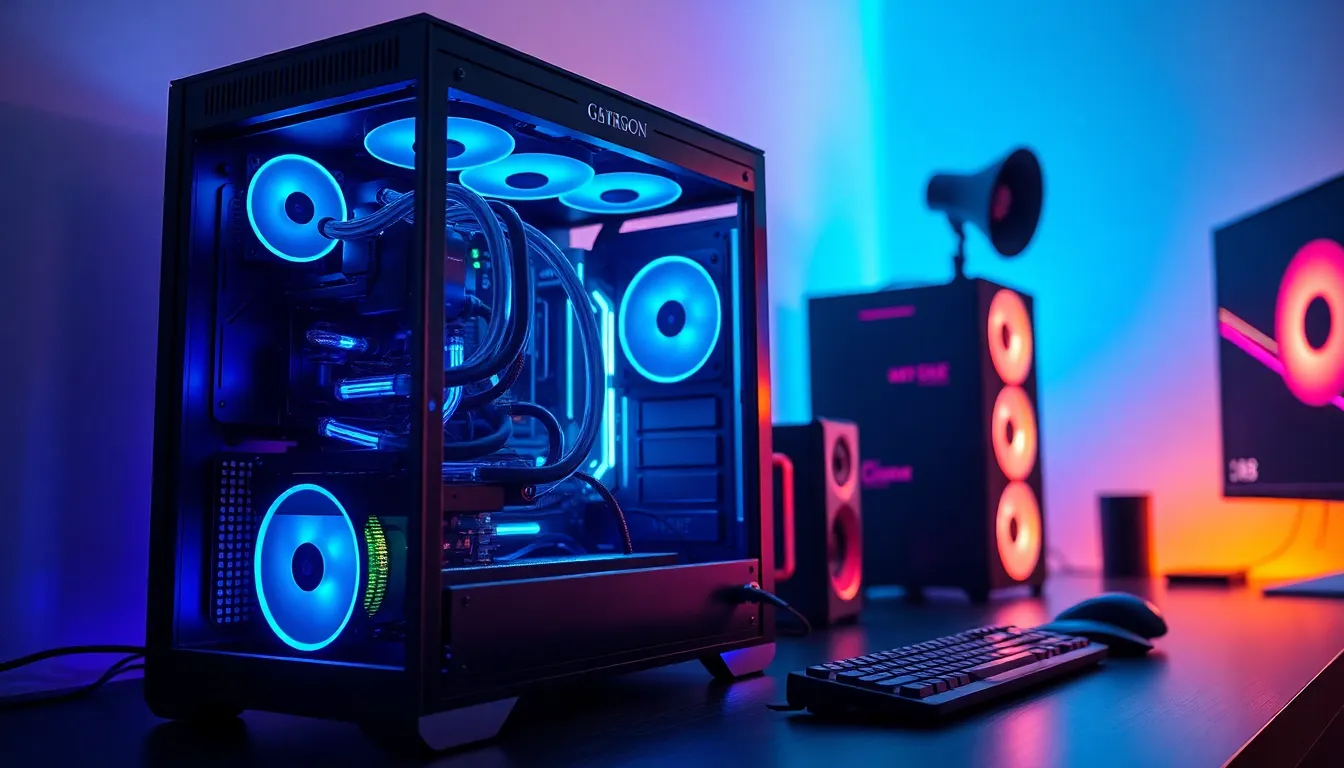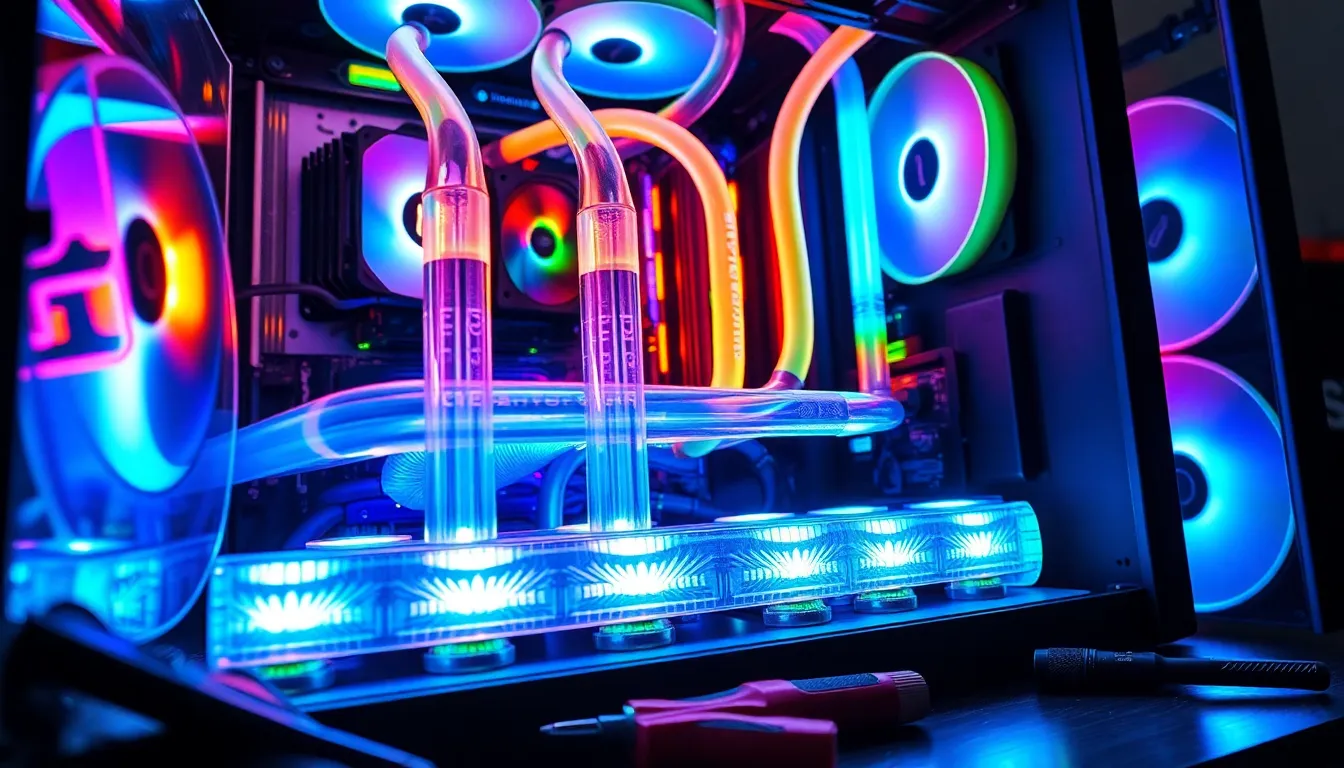In the world of gaming and high-performance computing, staying cool is the name of the game. Enter the water-cooled PC—a sleek, efficient, and downright cool way to keep those temperatures in check. Forget about noisy fans and thermal throttling; water cooling offers a silent yet powerful solution that’ll make your rig the envy of every gamer on the block.
Table of Contents
ToggleOverview Of Water Cooled PCs
Water-cooled PCs utilize liquid cooling systems to manage heat effectively. These systems circulate coolant through a series of tubes, cooling components like CPUs and GPUs. Many enthusiasts prefer this method for its ability to maintain lower temperatures during intensive tasks.
This cooling method operates silently compared to traditional air-based cooling. Fans often produce noise, but water-cooling solutions minimize this issue. In addition to quiet operation, users experience enhanced performance, as components stay cooler and avoid thermal throttling.
Components of a water-cooled PC include radiators, water blocks, pumps, and the coolant itself. Radiators disperse heat to the environment, while water blocks absorb heat from components. Pumps circulate the liquid, ensuring efficient heat transfer throughout the system.
Customization options make water cooling attractive. Custom loops allow users to design systems tailored to their aesthetics and performance needs. Many gamers enjoy customizing their rigs, incorporating vibrant colors and unique designs into their builds.
Choosing water cooling requires consideration of several factors. Cost often ranks high on the list, as these systems can be more expensive than air cooling alternatives. Additionally, maintenance comes into play; regular checks ensure leak prevention and optimal performance.
Users aiming for a powerful, quiet computing experience often find water cooling advantageous. Successful implementation can lead to lower temperatures, enhanced system performance, and a visually appealing setup. For those willing to invest in their PCs, water cooling provides significant benefits.
Benefits Of Water Cooling

Water cooling stands out due to its effectiveness in managing heat within high-performance systems. It addresses the cooling demands of powerful CPUs and GPUs efficiently, creating an optimal environment for gaming and computational tasks.
Improved Cooling Efficiency
Cooling efficiency reaches new heights with water-cooled PCs. The liquid coolant absorbs heat from components, transferring it to the radiator where it dissipates efficiently. This method allows for lower operating temperatures compared to traditional air cooling methods. Components operate at their peak performance, avoiding thermal throttling. Many enthusiasts report temperature drops of 20 to 30 degrees Fahrenheit compared to air cooling solutions. This improvement not only enhances overall system stability but also prolongs the lifespan of the hardware.
Noise Reduction
Noise reduction benefits users greatly with water cooling systems. Unlike noisy fans that create distracting sounds, water cooling operates almost silently. The lack of fan noise allows for a more immersive gaming experience and a calmer work environment. Many PC builders appreciate this quiet operation, especially during intense gaming sessions or demanding tasks. The reduced noise levels can contribute to overall comfort, making extended use more enjoyable. Users enjoy both performance and peace, which adds to the attraction of investing in water cooling solutions.
Components Of Water Cooling Systems
Water cooling systems consist of several essential components that work together to dissipate heat efficiently. Understanding these parts helps users make informed decisions when building or upgrading their water-cooled PCs.
Water Blocks
Water blocks play a pivotal role in transferring heat away from critical components like CPUs and GPUs. Each block contains channels for coolant flow, enhancing thermal conductivity. Material quality, such as copper or aluminum, impacts performance. Users often select water blocks based on compatibility with their hardware. Customization options allow enthusiasts to choose designs that complement their systems’ aesthetics.
Radiators
Radiators act as heat exchangers, allowing coolant to release absorbed heat into the surrounding air. They feature multiple fins designed to maximize surface area, improving heat dissipation efficiency. Common radiator sizes include 120mm, 240mm, and 360mm. Choosing an appropriate size depends on case dimensions and cooling needs. Additionally, fans attached to the radiators facilitate air movement, assisting in cooling performance.
Pumps
Pumps maintain coolant circulation throughout the system, ensuring optimal flow rates. Their design influences how effectively heat transfers from components to the radiator. Various styles exist, including submersible and inline models. Selecting the right pump depends on the system size and desired circulation speed. Reliable pumps are critical; malfunctioning units can lead to overheating and system failure.
Reservoirs
Reservoirs store excess coolant while allowing for easy system filling and maintenance. They help prevent air from entering the cooling loop, contributing to improved efficiency. Various shapes and sizes cater to different setups, from compact systems to larger builds. Users often opt for transparent reservoirs to showcase coolant colors and aesthetics. Integration with pumps enables seamless operation, further enhancing performance.
Installation Process
Installing a water-cooled PC involves several steps and requires specific tools. Careful planning ensures a smooth assembly experience.
Necessary Tools
A few essential tools facilitate the installation process. Screwdrivers enable users to secure components easily. Tubing cutters provide precision, making it simple to customize lengths for optimal routing. Thermal paste enhances heat transfer, ensuring efficient cooling between water blocks and components. Additionally, a filling funnel simplifies coolant filling and minimizes spills. Having a cloth handy helps with any potential mess during assembly.
Step-By-Step Guide
Follow these steps for a successful water-cooled PC setup. First, prepare the case by removing existing air-cooling components. Next, install the CPU water block, applying thermal paste before securing it. Connect tubing between the water block and radiator, ensuring a tight fit. Then, attach the pump to the reservoir and route the coolant. Fill the system with coolant, checking for leaks before powering up. Finally, test the system’s performance and monitor temperatures to ensure everything runs smoothly.
Water-cooled PCs stand out as an exceptional choice for gamers and high-performance users. They offer a unique combination of efficiency and silence that traditional cooling methods simply can’t match. By maintaining lower temperatures and reducing noise levels, these systems not only enhance performance but also contribute to a more enjoyable computing experience.
With the ability to customize setups to reflect personal style and performance needs, water cooling appeals to both enthusiasts and newcomers alike. While the initial investment and maintenance considerations are important, the long-term benefits in stability and hardware lifespan make water cooling a worthy consideration. For those seeking to elevate their gaming or computing experience, water cooling presents a powerful solution.




